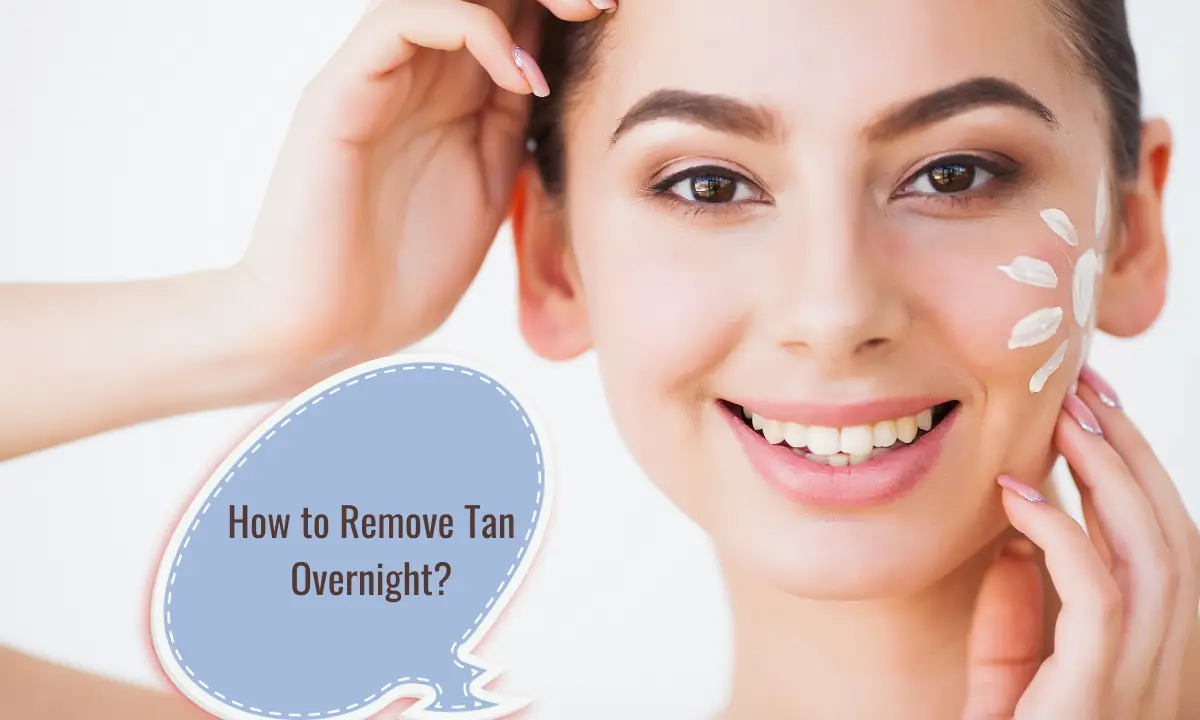Do you love spending time outdoors but dread the stubborn tan that follows? Tanning is a common skin concern caused by prolonged exposure to the sun’s harmful UV rays. While natural tanning gives your skin a bronzed glow, excessive tanning can leave it looking uneven, dull, and tired.
If you’re looking for effective solutions to remove tan overnight, you’ve come to the right place! In this article, we’ll explore simple and safe remedies that work wonders—most of them using ingredients you already have at home. Whether it’s a quick DIY mask or a reliable skincare product, we’ve got you covered.
Ready to reclaim your glowing, even-toned skin? Let’s dive in!
Why Removing Tan Overnight Is Possible
The idea of completely removing tan overnight might sound too good to be true, but it’s not entirely impossible! While severe tanning may require a longer-term approach, there are certain remedies and products that can significantly reduce pigmentation, restore your skin’s natural glow, and improve its texture in just one night.
Here’s how it works:
- Exfoliation: Gentle scrubs help remove dead skin cells, which are often the most tanned layers of your skin.
- Natural Bleaching Agents: Ingredients like lemon, tomato, and potato contain natural acids and antioxidants that lighten pigmentation and brighten skin.
- Hydration and Soothing: Ingredients like aloe vera and cucumber calm inflammation caused by UV rays, reducing redness and improving skin tone.
- Active Ingredients in Skincare Products: Over-the-counter products like vitamin C serums or glycolic acid peels work overnight to brighten skin and even out complexion.
While these remedies don’t replace a long-term skincare routine, they are highly effective for quick, visible improvements.
Top 10 Remedies to Remove Tan Overnight
Here are the most effective remedies to help you wake up with visibly brighter and more even-toned skin. These remedies include natural ingredients and some quick product-based solutions for those looking for instant results.
Natural Remedies
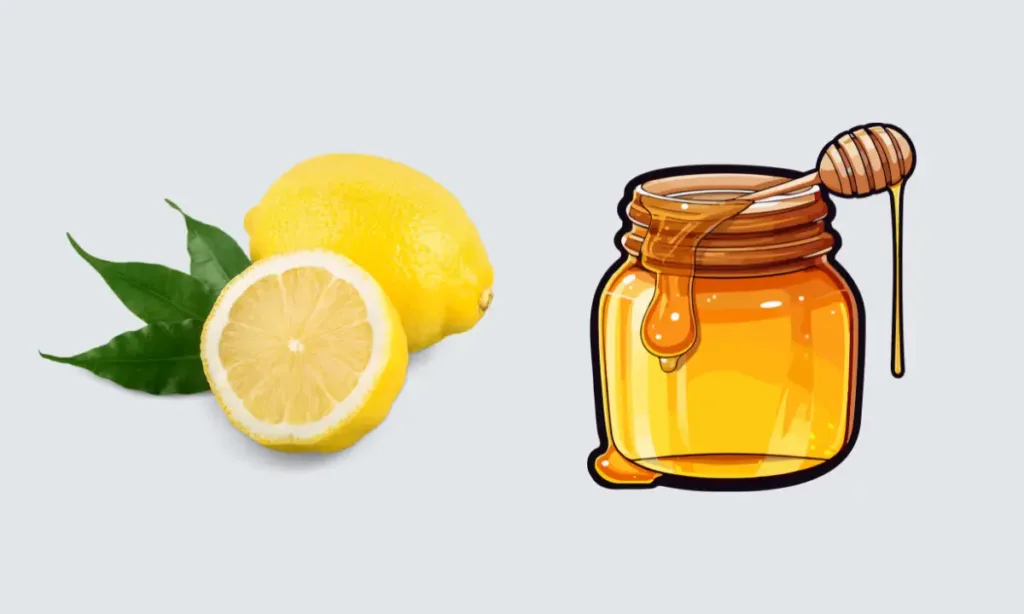
1. Lemon and Honey Mask
Why It Works: Lemon is a powerhouse of natural citric acid and vitamin C, which help lighten pigmentation and reduce tan by exfoliating the top layer of skin. Honey acts as a humectant, locking in moisture while soothing and nourishing the skin, ensuring it stays hydrated and soft.
How to Use:
- Mix 1 tablespoon of fresh lemon juice with 1 tablespoon of raw, organic honey in a small bowl.
- Apply the mixture evenly to the tanned areas using a clean brush or your fingertips.
- Leave it on for 20 minutes to allow the ingredients to penetrate and work on the pigmentation.
- Rinse off gently with lukewarm water and pat dry.
Pro Tip:
- Avoid direct sun exposure after using lemon-based remedies, as it can make your skin photosensitive.
- For sensitive skin, dilute the lemon juice with water or skip it altogether to prevent irritation.
Frequency: Use this remedy 2-3 times a week for best results. Avoid daily application, as lemon’s acidity may dry out the skin over time.
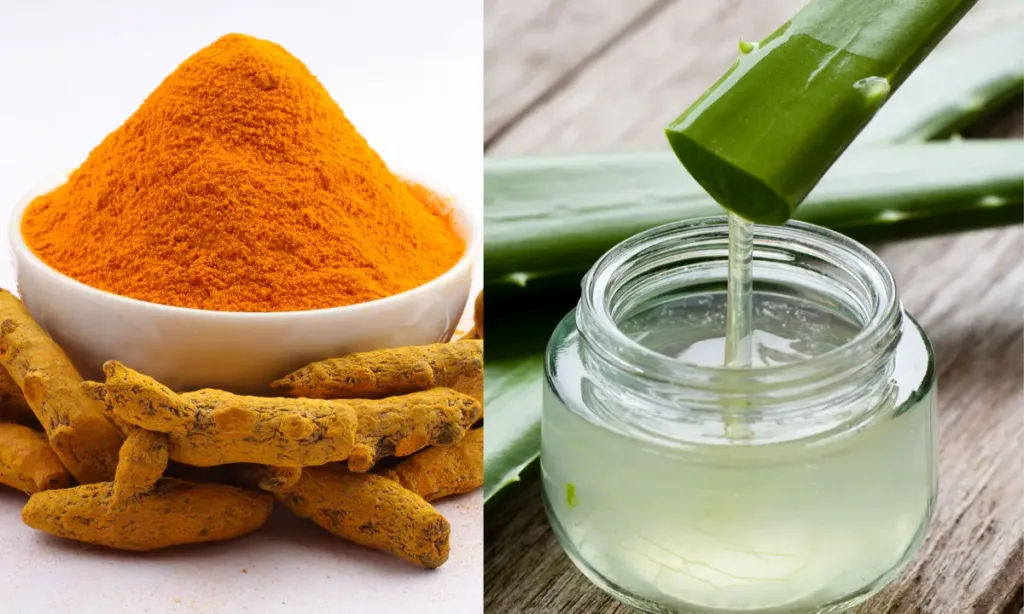
2. Aloe Vera Gel with Turmeric
Why It Works: Aloe vera is a powerhouse of hydration and healing, packed with vitamins and antioxidants that soothe sun-damaged skin and repair it overnight. Turmeric contains curcumin, a natural anti-inflammatory and brightening agent that reduces tan and promotes an even skin tone.
How to Use:
- Take 2 tablespoons of fresh or store-bought aloe vera gel (ensure it’s 100% pure without added chemicals).
- Add a pinch of turmeric powder and mix well to form a smooth, yellow-tinted gel.
- Apply the mixture generously to the tanned areas, focusing on affected spots.
- Leave it on overnight to allow your skin to absorb the nutrients fully.
- In the morning, rinse off with cool water and pat dry.
Pro Tip: If you’re concerned about turmeric staining your skin, use a very small quantity or opt for wild turmeric, which has reduced staining properties.
Frequency: Use this remedy nightly for 3-4 days in a row to see noticeable results.
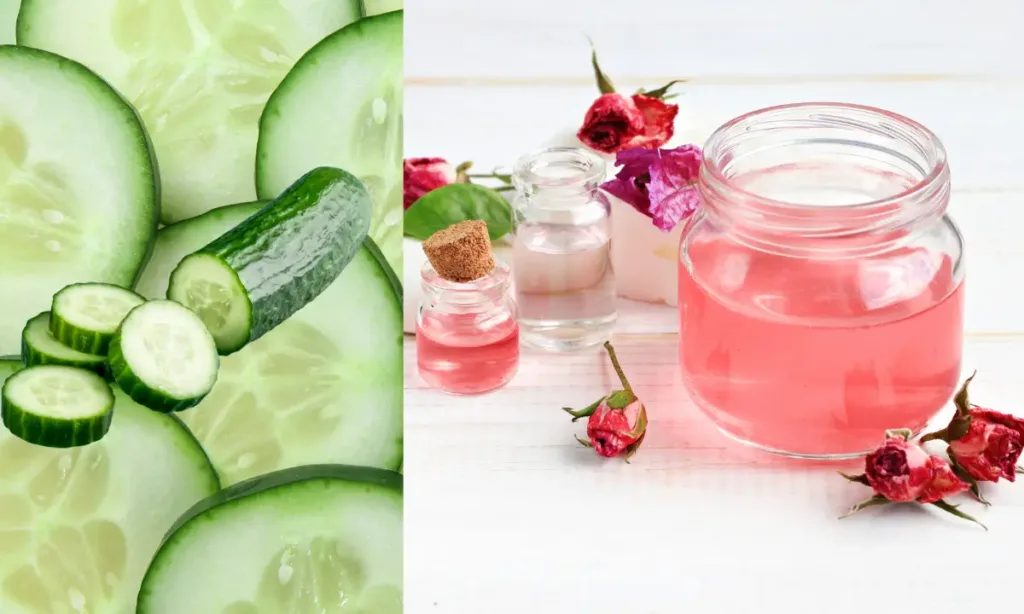
3. Cucumber and Rose Water Pack
Why It Works: Cucumber is packed with antioxidants and cooling properties that reduce inflammation, soothe sunburn, and hydrate the skin. Rose water acts as a natural toner, balancing the skin’s pH and providing a refreshing glow. Together, they help calm sun-damaged skin and reduce tan.
How to Use:
- Take half a cucumber, peel it, and grate it finely.
- Mix the grated cucumber with 2 tablespoons of rose water to create a watery paste.
- Chill the mixture in the refrigerator for 10-15 minutes for an extra cooling effect.
- Apply the mixture generously to the tanned areas using a cotton pad or clean fingers.
- Leave it on for 30 minutes to allow your skin to absorb the nutrients.
- Rinse off with cold water and gently pat dry.
Pro Tip: For added nourishment, mix a teaspoon of aloe vera gel into the pack. This will boost hydration and enhance the tan-removal process.
Frequency: Use daily for quick relief from tanning and a cooling effect during summer.
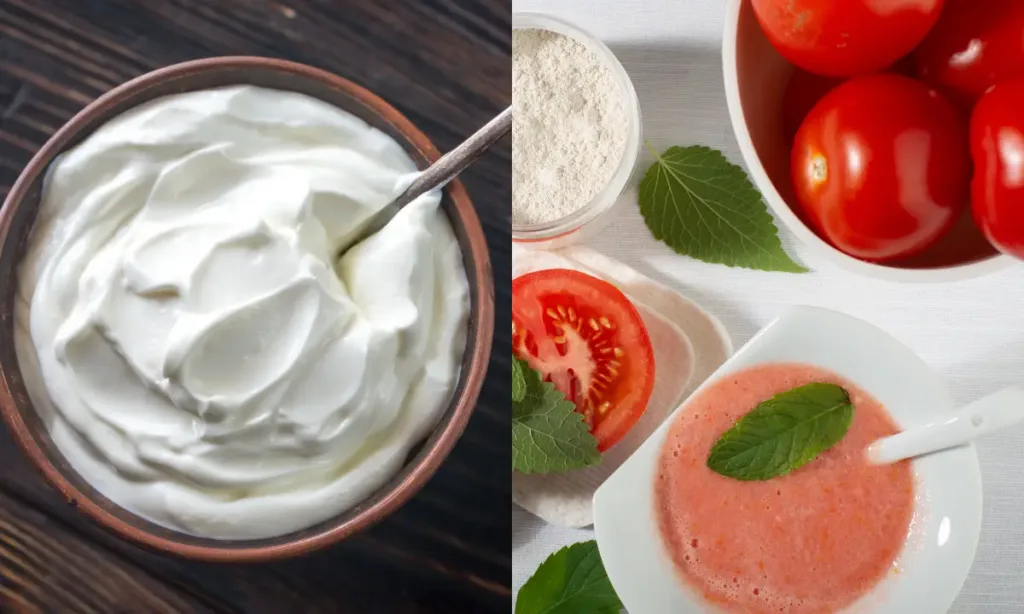
4. Tomato Pulp and Yogurt Mask
Why It Works: Tomatoes are rich in natural acids and antioxidants like lycopene, which help lighten pigmentation, reduce tan, and brighten the skin. Yogurt contains lactic acid that exfoliates gently while providing deep hydration, leaving the skin smooth and refreshed.
How to Use:
- Take one ripe tomato, wash it thoroughly, and blend it into a smooth pulp.
- Mix 1 tablespoon of plain yogurt (unsweetened and unflavored) into the tomato pulp until it forms a consistent paste.
- Apply the mixture evenly across the tanned areas of your skin.
- Let the mask sit for 20-25 minutes to allow the ingredients to penetrate and work on reducing pigmentation.
- Rinse off with lukewarm water and pat dry with a soft towel.
Pro Tip: If your skin is oily, add a few drops of lemon juice for an extra brightening effect. For sensitive skin, replace lemon with a pinch of turmeric for a soothing touch.
Frequency: Use this mask 2-3 times a week for noticeable results.
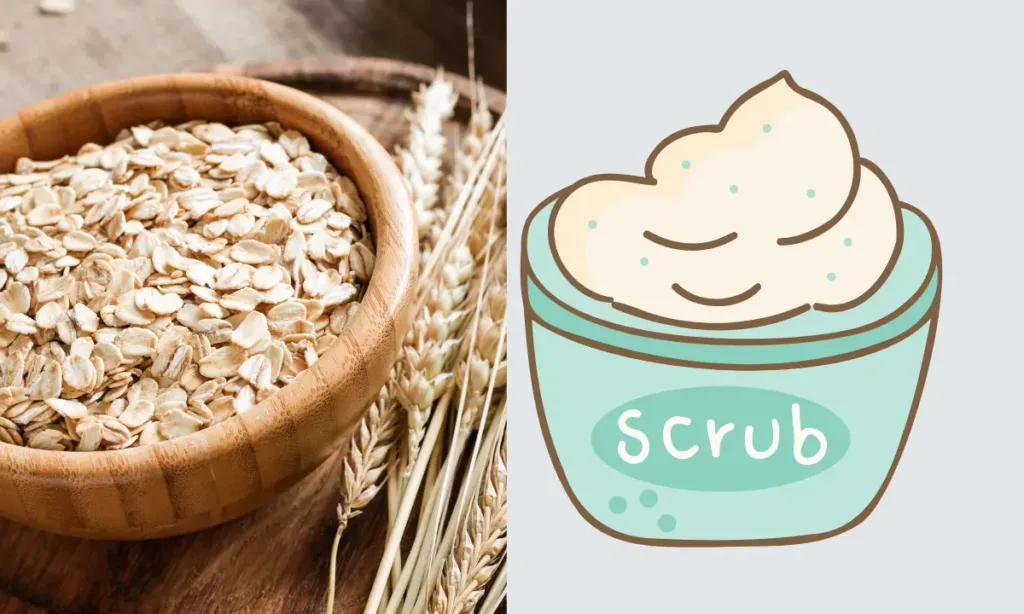
5. Oatmeal and Milk Scrub
Why It Works: Oatmeal acts as a natural exfoliant, gently removing dead skin cells and impurities, while milk contains lactic acid that brightens the skin and reduces tan by breaking down pigmented cells.
How to Use:
- Take 2 tablespoons of oatmeal in a bowl.
- Add enough milk to create a thick, spreadable paste.
- Apply the paste to your face or affected areas.
- Gently massage in circular motions for 2-3 minutes to exfoliate the skin.
- Let it sit for an additional 10 minutes to allow the lactic acid to work on the tan.
- Rinse off with lukewarm water and pat dry.
Pro Tip: For added hydration, mix in a teaspoon of honey to the scrub. Use this remedy 2-3 times a week for the best results.
Quick OTC (Over-the-Counter) Options
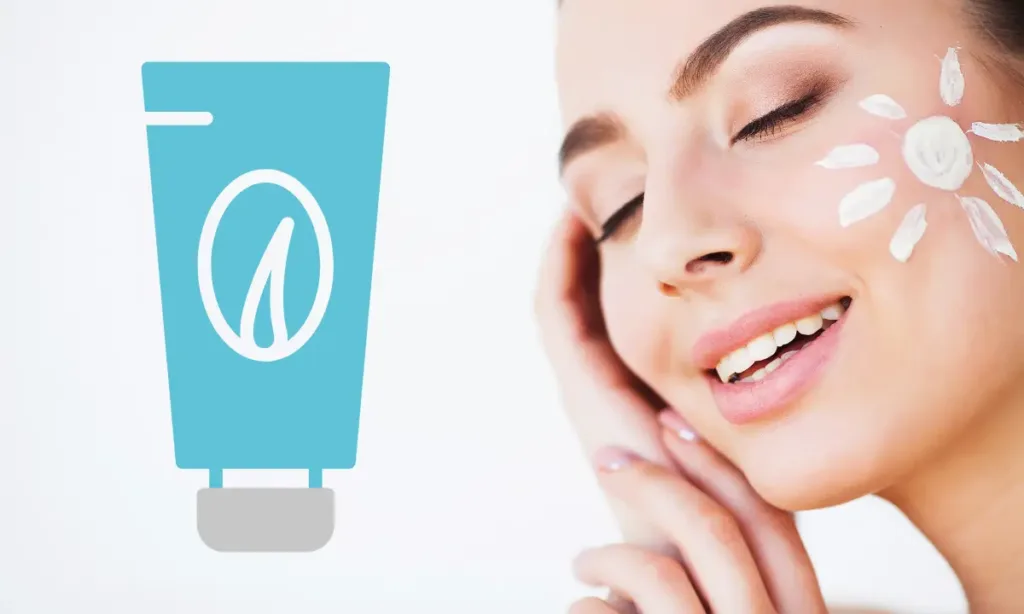
6. Tan Removal Creams
Why It Works: Tan removal creams are formulated with active ingredients like kojic acid, vitamin C, glycolic acid, or niacinamide, which target pigmentation and promote a brighter, even skin tone. These ingredients work by reducing melanin production and exfoliating the outer layer of tanned skin.
How to Choose:
- Look for creams labeled as “tan removal” or “brightening.”
- Check for active ingredients like kojic acid, alpha-arbutin, or licorice extract.
- Opt for creams that are paraben-free and dermatologically tested, especially if you have sensitive skin.
Recommended Use:
- Cleanse your face before applying the cream to ensure it absorbs effectively.
- Use a pea-sized amount and massage gently onto the tanned areas.
- For best results, apply at night and follow up with sunscreen the next morning to prevent further tanning.
Pro Tip: Consult a dermatologist for recommendations tailored to your skin type, especially if you have severe tanning or pigmentation issues.
7. Exfoliating Peels or Pads
Why It Works: Exfoliating peels or pads contain active ingredients like glycolic acid, lactic acid, or salicylic acid that work to gently dissolve dead skin cells and remove the outermost layer of tanned skin. This process reveals fresh, brighter, and more even-toned skin underneath while improving skin texture over time.
How to Use:
- Choose an exfoliating peel or pad that suits your skin type. Look for products with a low concentration of acids (5-10%) if you’re new to chemical exfoliation.
- At night, after cleansing your skin, apply the peel or swipe the pad gently across the tanned areas, avoiding the eye and lip areas.
- Allow it to work overnight. Do not rinse unless instructed on the product label.
- In the morning, wash your face with a gentle cleanser and apply a broad-spectrum sunscreen (SPF 30+), as exfoliation makes your skin more sensitive to the sun.
Pro Tip: Use 1-2 times a week to avoid over-exfoliation, which can lead to redness and irritation. For beginners, start with once a week and observe your skin’s reaction.
Precautions:
- Avoid using physical scrubs or other exfoliating products on the same day to prevent skin damage.
- Patch-test the product on a small area of your skin before full application, especially if you have sensitive skin.
8. Brightening Serums
Why It Works: Brightening serums are formulated with active ingredients like vitamin C, niacinamide, or alpha arbutin that work to reduce pigmentation, inhibit melanin production, and promote a more even skin tone. These serums are lightweight, penetrate deeply, and work overnight to leave your skin visibly brighter and refreshed by morning.
How to Use:
- Cleanse your face thoroughly to remove dirt and oil, ensuring your skin is prepared to absorb the serum.
- Take 2-3 drops of the serum and apply it evenly to your face or the affected areas using gentle tapping motions with your fingers.
- Follow up with a moisturizer to lock in hydration and enhance the effectiveness of the serum.
- Use at night for maximum results, as most brightening serums work best without exposure to sunlight.
Pro Tip: Always use sunscreen during the day after applying brightening serums the previous night, as active ingredients like vitamin C can make your skin more sensitive to the sun.
Precautions:
- Avoid using serums with high concentrations (e.g., vitamin C >20%) if you’re new to active skincare to prevent irritation.
- If combining with other products, avoid layering brightening serums with strong exfoliants or retinoids on the same night.
Frequency: Use once daily, preferably at night, and consistently for at least 2-4 weeks to see visible results.
Other Instant Tan Removal Techniques
9. Cold Compress with Milk
Why It Works: Milk is a natural source of lactic acid, which gently exfoliates and lightens pigmented skin, helping to reduce tan. Its cooling properties soothe irritation and inflammation caused by sun exposure, leaving your skin feeling refreshed and hydrated.
How to Use:
- Take a small bowl of chilled milk (preferably full-fat for extra hydration).
- Soak a clean cotton pad or soft cloth in the milk until fully saturated.
- Gently press the pad onto the tanned areas, ensuring full coverage.
- Leave it on for 15-20 minutes to allow the lactic acid to work on the pigmentation.
- Rinse off with cool water and pat dry with a soft towel.
Pro Tip: For added benefits, mix a teaspoon of rose water or a pinch of turmeric into the milk before soaking the cotton pad. This enhances hydration and adds a mild brightening effect.
Frequency: Use daily or every alternate day for best results, especially during summer when skin is prone to tanning.
10. Potato Juice
Why It Works: Potato is rich in catecholase, a natural enzyme known to reduce melanin production, which helps lighten pigmentation and tan. Its cooling properties also soothe sunburned or irritated skin, making it an excellent remedy for sun damage.
How to Use:
- Take a fresh, medium-sized raw potato and peel it.
- Grate or blend the potato, then strain the pulp through a clean cloth or sieve to extract the juice.
- Dip a cotton ball or pad into the juice and apply it generously to the tanned areas.
- Let it sit for 20-25 minutes, allowing the juice to absorb into your skin.
- Rinse off with cool water and gently pat dry.
Pro Tip: For extra hydration, mix the potato juice with a teaspoon of honey or cucumber juice before applying. This helps to prevent dryness and enhance the soothing effect.
Frequency: Use this remedy daily for noticeable results within a week.
These remedies are quick, easy, and effective for reducing tan overnight. For the best results, pick a method that suits your skin type and follow the instructions carefully.
Also Read: Best Body Lotions for Winter: Keep Your Skin Hydrated and Soft All Season.

Step-by-Step DIY Routine for Overnight Tan Removal
If you’re looking for a quick and easy routine to remove tan overnight, follow this step-by-step guide. This routine combines the benefits of cleansing, targeted treatment, and hydration to ensure your skin looks radiant by morning.
1. Cleanse Your Skin
Cleansing is the foundation of any skincare routine. Start by using a mild cleanser to remove dirt, sweat, and excess oil that can block the absorption of remedies or products. A clean base ensures that your skin reaps the full benefits of the tan removal treatments you’ll apply later.
Steps to Cleanse:
- Wet your skin with lukewarm water to open up your pores gently.
- Take a small amount of cleanser and massage it onto your skin in gentle, circular motions.
- Focus on areas where you tend to sweat or have visible tan lines.
- Rinse thoroughly and pat dry with a soft towel—avoid rubbing to prevent irritation.
Pro Tip: Choose a cleanser with soothing ingredients like aloe vera or cucumber for extra hydration and to calm any redness or irritation caused by sun exposure.
2. Exfoliate Gently
Exfoliation is a crucial step to remove dead skin cells and prepare your skin for the tan-removal remedy. Choose a natural scrub like the Oatmeal and Milk Scrub for a DIY approach, or opt for a store-bought exfoliator with gentle ingredients suited to your skin type.
- How to Exfoliate:
- Apply a small amount of the scrub or exfoliator to damp skin.
- Using your fingertips, gently massage the product onto the tanned areas in circular motions for 2-3 minutes. Avoid scrubbing too hard to prevent irritation.
- Rinse thoroughly with lukewarm water and pat your skin dry with a clean towel.
- Pro Tip: If your skin feels sensitive, limit exfoliation to twice a week. For an extra soothing effect, choose scrubs with hydrating ingredients like honey or milk.
3. Apply a Targeted Remedy
Choose a remedy tailored to your skin type for the best results. This step ensures your skin receives the right care to reduce tan while addressing specific needs like hydration, oil control, or soothing irritation.
Remedy Options:
- Normal to Dry Skin: Apply the Lemon and Honey Mask for a natural brightening effect and a boost of hydration. Mix 1 tablespoon each of lemon juice and honey, apply evenly, and leave it on for 20 minutes.
- Oily Skin: Use the Tomato Pulp and Yogurt Mask to control excess oil and lighten pigmentation. Blend one ripe tomato into a pulp, mix it with 1 tablespoon of plain yogurt, and apply for 25 minutes.
- Sensitive Skin: Opt for the Cucumber and Rose Water Pack to soothe irritation and cool the skin. Grate half a cucumber, mix it with 2 tablespoons of rose water, and leave it on for 30 minutes.
How to Apply:
- Ensure your skin is freshly cleansed and dry.
- Apply the chosen remedy evenly to the tanned areas using clean fingers or a brush.
- Leave it on for the recommended duration (15-30 minutes, depending on the remedy).
- Rinse off with lukewarm water and gently pat your skin dry.
Pro Tip: For enhanced results, use chilled ingredients to add a cooling effect and reduce inflammation.
4. Use a Night Serum
Night serums are packed with powerful active ingredients like vitamin C, niacinamide, or alpha arbutin that work wonders on your skin while you sleep. These ingredients target pigmentation, boost skin repair, and help brighten your complexion overnight.
How to Use:
- After cleansing your skin, take 2-3 drops of your chosen serum onto your fingertips.
- Gently pat or massage the serum into your skin, focusing on tanned areas.
- Wait a minute or two for the serum to fully absorb before applying your moisturizer.
Pro Tip: For added hydration and protection, follow up with a lightweight moisturizer or sleeping mask after applying the serum. Always apply sunscreen the next day to protect your skin, as serums can make it more sensitive to sunlight.
5. Moisturize and Lock in Hydration
Hydration is the final and most important step to ensure your skin feels soft, nourished, and ready to repair itself overnight. A good moisturizer creates a barrier that locks in the benefits of the serum or remedy you’ve applied, helping your skin stay hydrated and plump.
How to Moisturize:
- Take a small amount of moisturizer (about a pea-sized dollop) and warm it between your fingers.
- Gently apply it to your face and neck, focusing on any areas that feel dry or tight.
- Massage in upward motions to boost circulation and ensure even absorption.
What to Look For:
- Dry Skin: Opt for moisturizers with rich ingredients like shea butter or ceramides.
- Oily Skin: Choose a lightweight, gel-based moisturizer with non-comedogenic ingredients.
- All Skin Types: Look for hydration-boosting ingredients like aloe vera, hyaluronic acid, or glycerin.
Pro Tip: For an extra hydration boost, apply a sleeping mask or gel-based moisturizer as the final step of your routine. This seals in moisture and gives your skin a dewy glow by morning.
Optional: Spot Treatment
If certain areas of your skin have stubborn tan lines or darker pigmentation, a targeted spot treatment can help lighten these patches more effectively. Use quick, natural remedies as the final step in your routine to address these specific concerns.
- How to Spot Treat:
- Potato Juice: Dab freshly extracted potato juice onto the tanned spots using a cotton ball. Leave it on for 20 minutes or overnight for maximum effect, then rinse off in the morning.
- Cold Compress with Milk: Soak a cotton pad in chilled milk and press it onto the affected areas for 10-15 minutes. The lactic acid and cooling properties will help lighten the tan and calm any irritation.
- Pro Tip: For added effectiveness, you can alternate between remedies on different nights or combine them by applying the potato juice first, letting it dry, and then following up with the milk compress.
- When to Use: Perform spot treatments 2-3 times a week to avoid over-treating the skin while still addressing stubborn pigmentation.
This routine is easy to follow and highly effective when combined with the right remedies or products. You’ll wake up with brighter, healthier-looking skin that feels soft and refreshed.
Also Check Out: सबसे अच्छा फेस वॉश – सभी प्रकार के त्वचा लिए बेहतरीन सुझाव
Tips to Maximize Results
To ensure you get the best possible results from your overnight tan removal routine, follow these additional tips. These simple practices can enhance the effectiveness of your remedies and leave your skin looking even more radiant.
1. Stay Hydrated
Keeping your skin hydrated starts from within. Drinking enough water throughout the day not only helps flush out toxins but also supports skin repair and rejuvenation overnight. Hydrated skin is more resilient, making it less prone to dryness, dullness, or uneven tone caused by tanning.
How to Stay Hydrated:
- Aim for 8-10 glasses of water daily.
- Sip water consistently throughout the day instead of drinking large amounts all at once.
- Include hydrating foods like watermelon, cucumbers, and oranges in your diet.
Pro Tip: Add a slice of lemon, cucumber, or a few mint leaves to your water for a refreshing twist and additional skin-boosting benefits like vitamin C or antioxidants.
2. Avoid Harsh Chemicals
Using harsh products can do more harm than good, especially when your skin is already stressed from tanning. Soaps with strong detergents or alcohol-based toners can strip your skin of its natural oils, leaving it dry, irritated, and more susceptible to damage.
What to Avoid:
- Harsh soaps that leave your skin feeling tight or squeaky clean.
- Alcohol-based toners, which can dry out your skin and disrupt its natural barrier.
What to Use Instead:
- Opt for gentle, pH-balanced cleansers and toners with soothing ingredients like rose water or chamomile.
- Stick to natural or hypoallergenic products to maintain your skin’s moisture and health.
Pro Tip: Check product labels for common irritants like sulfates, parabens, and synthetic fragrances, and avoid these whenever possible.
3. Use Lukewarm Water
The temperature of the water you use to cleanse your skin plays a significant role in maintaining its health. Lukewarm water strikes the perfect balance—it’s gentle enough to prevent dryness and irritation, yet effective in removing products and remedies from your skin.
Why Lukewarm Water?:
- Hot Water: Strips your skin of its natural oils, leaving it dry and prone to irritation.
- Cold Water: Doesn’t cleanse as effectively, which may leave behind residue from remedies or products.
Pro Tip: After rinsing with lukewarm water, splash your face with cool water to tighten pores and refresh your skin.
4. Protect Your Skin Post-Treatment
Your skin is extra sensitive after an overnight tan-removal routine, so protecting it the next day is essential. Applying sunscreen acts as a shield, preventing further damage and helping your skin maintain its newfound glow.
How to Protect:
- Use a broad-spectrum sunscreen with SPF 30 or higher, even if you’re indoors, as UV rays can penetrate windows.
- Reapply every 2-3 hours if you’re outside or sweating to ensure consistent protection.
Pro Tip: Pair your sunscreen with protective accessories like wide-brimmed hats or scarves when heading out for extra defense against UV rays.
5. Maintain a Healthy Diet
What you eat has a direct impact on your skin’s ability to repair and renew itself. A diet rich in antioxidants and vitamins not only helps reduce tan but also promotes overall skin health, giving you a radiant, natural glow from within.
Skin-Loving Nutrients:
- Antioxidants: Found in berries, spinach, and green tea, these fight free radicals caused by sun exposure, reducing skin damage.
- Vitamin C: Boosts collagen production and brightens skin tone. Include citrus fruits, kiwi, and bell peppers.
- Vitamin E: Hydrates and protects skin. Found in nuts, seeds, and avocados.
Pro Tip: Drink green tea daily for a double dose of antioxidants—great for both your skin and overall health.
6. Be Consistent
While these remedies show significant results overnight, consistency is key for maintaining long-term improvements. Incorporate these practices into your weekly skincare routine to keep tan at bay.
By following these tips, you’ll amplify the results of your tan removal remedies and enjoy long-lasting, glowing skin.
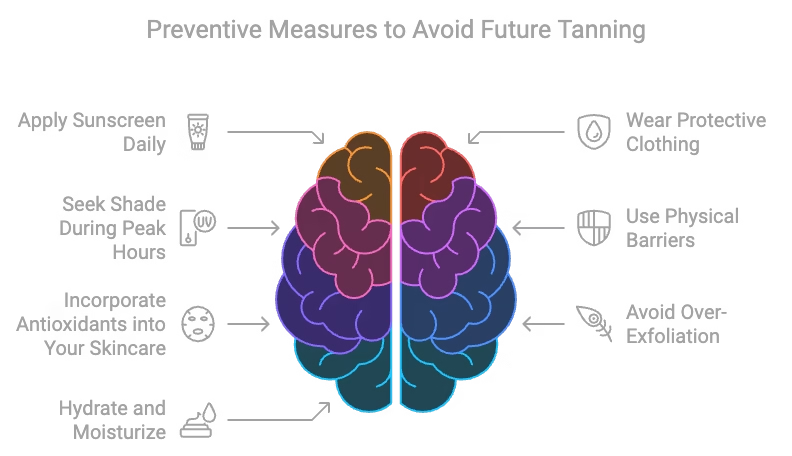
Preventive Measures to Avoid Future Tanning
While removing tan overnight can provide instant relief, the key to maintaining healthy, even-toned skin is prevention. Incorporate these tips into your daily routine to protect your skin from further tanning and damage.
1. Apply Sunscreen Daily
Sunscreen is your skin’s best defense against tanning and sun damage. A broad-spectrum sunscreen with SPF 30 or higher protects you from harmful UVA and UVB rays, reducing the risk of pigmentation, tanning, and premature aging.
How to Use:
- Apply sunscreen generously to all exposed areas of skin 15-20 minutes before stepping outside.
- Reapply every 2-3 hours, especially if you’re sweating or swimming, to maintain protection.
- Don’t forget often-missed spots like your ears, neck, and the back of your hands.
Pro Tip: Choose a lightweight, non-comedogenic sunscreen for daily use to avoid clogged pores and greasy skin. If you wear makeup, opt for a sunscreen that sits well under it or use a spray sunscreen for easy reapplication.
2. Wear Protective Clothing
Clothing is your first line of defense against harmful UV rays and tanning. Choosing the right outfits can shield your skin while keeping you comfortable, especially in sunny or hot conditions.
How to Protect with Clothing:
- Opt for long-sleeved tops, full-length pants, and wide-brimmed hats to cover exposed areas.
- Wear sunglasses with UV protection to safeguard your eyes and the delicate skin around them.
- Choose light, breathable fabrics like cotton or linen to stay cool while blocking out the sun.
Pro Tip: Look for clothing labeled with UPF (Ultraviolet Protection Factor) for added sun protection, especially if you spend long hours outdoors.
3. Seek Shade During Peak Hours
The sun’s UV rays are at their strongest between 10 a.m. and 4 p.m., making this the riskiest time for tanning and skin damage. Limiting your exposure during these hours can significantly reduce the chances of sunburn and tan.
How to Stay Safe:
- Plan outdoor activities for early morning or late afternoon when the sun is less intense.
- Use an umbrella or stay under shaded areas like trees or awnings if you need to be outside.
- Wear portable shade gear, like a wide-brimmed hat or UV-blocking scarf, for added protection.
Pro Tip: Check the UV index for your area before heading out. Apps and weather services often provide this information to help you plan your day wisely.
4. Use Physical Barriers
Adding an extra layer of protection with UV-blocking accessories is an easy and effective way to shield your skin from harmful rays. These barriers are especially useful for long drives or extended outdoor activities when sunscreen alone might not be enough.
How to Use Physical Barriers:
- Wear UV-blocking arm sleeves to protect your arms during outdoor activities or while driving.
- Use lightweight scarves or shawls to cover your neck, shoulders, and face without feeling overheated.
- Don gloves to protect your hands, which are often exposed to the sun and prone to pigmentation.
Pro Tip: Look for accessories made with UPF (Ultraviolet Protection Factor) fabric for maximum sun protection. They’re designed to block UV rays effectively while being breathable and comfortable.
5. Incorporate Antioxidants into Your Skincare
Antioxidants are your skin’s secret weapon against sun damage and tanning. They neutralize free radicals caused by UV rays, helping to repair damage, reduce pigmentation, and protect your skin from future harm.
How to Use Antioxidants:
- Look for serums or moisturizers containing powerful antioxidants like vitamin C, green tea extract, or niacinamide.
- Apply a vitamin C serum in the morning after cleansing to brighten skin and boost your sunscreen’s effectiveness.
- Use products with green tea or niacinamide at night to soothe and repair your skin as you sleep.
Pro Tip: Store vitamin C serums in a cool, dark place to preserve their potency, as they can degrade when exposed to light and heat.
Bonus Benefit: Regular use of antioxidant-rich products not only protects against tanning but also promotes an even skin tone and youthful glow.
6. Avoid Over-Exfoliation
Exfoliation is an effective way to remove tan and dead skin cells, but overdoing it can backfire. Excessive exfoliation can strip your skin’s natural barrier, making it more sensitive to UV rays and prone to irritation.
How to Exfoliate Safely:
1. Limit exfoliation to 2-3 times a week, depending on your skin type.
- Oily Skin: Stick to 2-3 times a week.
- Dry or Sensitive Skin: Reduce to once or twice a week.
2. Use gentle exfoliants like oatmeal-based scrubs or mild chemical exfoliants containing lactic acid or PHA.
3. Always follow up with a hydrating moisturizer to restore your skin’s natural barrier.
Pro Tip: Avoid combining exfoliation with other strong treatments, like retinol or vitamin C, on the same day to prevent over-sensitizing your skin.
Why It’s Important: Over-exfoliation can lead to redness, dryness, and an increased risk of UV damage—undoing all your efforts to remove tan and maintain healthy skin.
7. Hydrate and Moisturize
Hydration is the key to healthy, glowing, and resilient skin. Properly moisturized skin is better equipped to defend itself against sun damage, reduce dryness, and repair itself after exposure to UV rays.
How to Keep Skin Hydrated:
- Use a lightweight moisturizer in the morning with hydrating ingredients like hyaluronic acid or glycerin to lock in moisture throughout the day.
- For nighttime, opt for richer formulations or products with aloe vera to soothe and heal the skin while you sleep.
- Consider using a hydrating mist or spray during the day to keep your skin fresh and plump, especially in hot or dry weather.
Pro Tip: For maximum hydration, apply moisturizer while your skin is still slightly damp after cleansing. This helps trap water in the skin and boosts its hydrating effect.
Bonus Benefit: Keeping your skin hydrated not only reduces sun damage but also helps maintain an even skin tone and a smoother, more youthful appearance.
By adopting these preventive measures, you can significantly reduce the risk of tanning and maintain a radiant, even skin tone in the long term.
FAQs About Tan Removal
Here are answers to some of the most frequently asked questions about removing tan, ensuring you have all the information you need for effective results.
While severe tanning may not completely vanish overnight, many remedies and products can significantly reduce pigmentation and brighten your skin within hours. Consistency is key for lasting results.
Natural remedies are gentle and suitable for most skin types, especially if you’re looking for a chemical-free option. However, store-bought products with active ingredients like vitamin C, niacinamide, or glycolic acid often deliver faster results.
Most natural remedies can be used 2-3 times a week, depending on your skin’s tolerance. Over-the-counter products should be used as per their instructions to avoid overuse or irritation.
Yes, it’s possible to remove tan over time by following a consistent skincare routine. Severe tanning may take a few weeks of dedicated care, but regular exfoliation, hydration, and sunscreen use can restore your natural skin tone.
Combine a brightening serum with a gentle exfoliating scrub, followed by a soothing mask like aloe vera and turmeric. Finish with a moisturizer for a fresh, glowing look.
These FAQs cover everything you need to know about tackling tan effectively. If you have more questions, feel free to drop them in the comments section!
Conclusion
Sun tanning is a common concern, but with the right remedies and preventive measures, you can achieve radiant, even-toned skin overnight. From natural remedies like lemon and honey masks to quick fixes like brightening serums, there’s a solution for everyone. The key is to choose a method that suits your skin type and follow it consistently.
Remember, while removing tan overnight is possible to some extent, long-term results require a combination of care and protection. Always use sunscreen, stay hydrated, and embrace a skincare routine that prioritizes your skin’s health.
Now it’s your turn! Which remedy are you excited to try? Have a favorite tan removal trick of your own? Share it in the comments—we’d love to hear from you!
